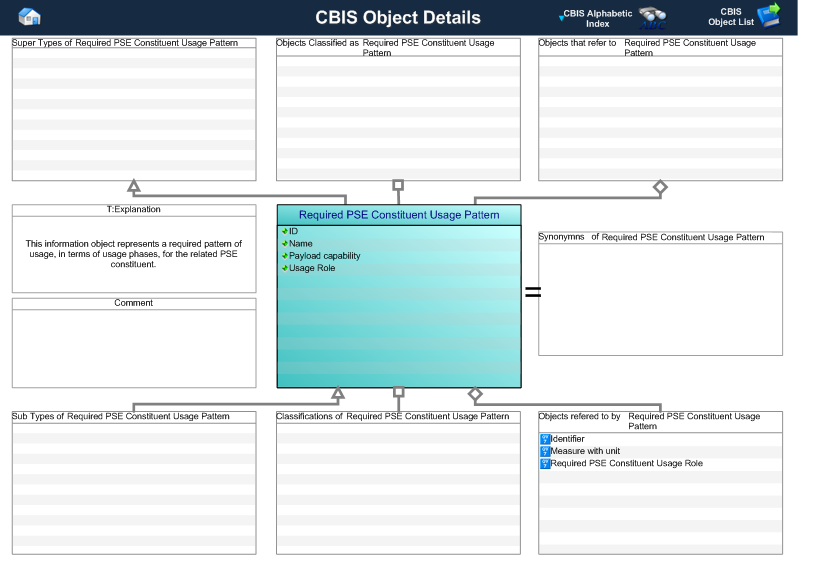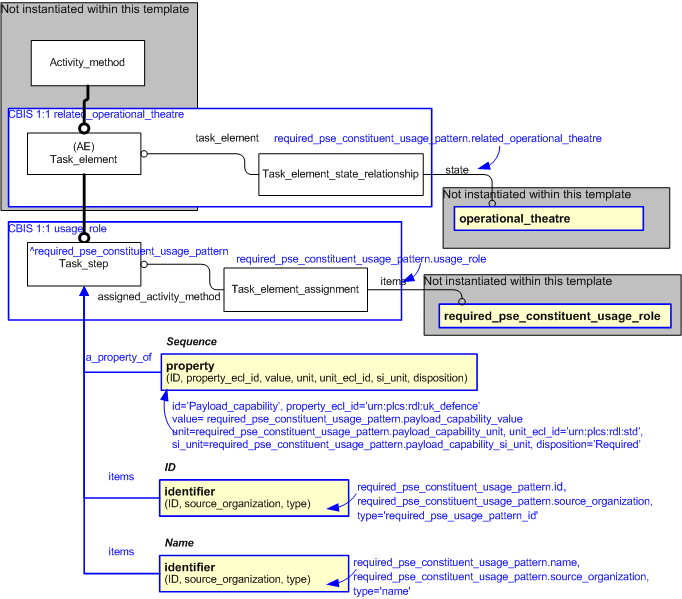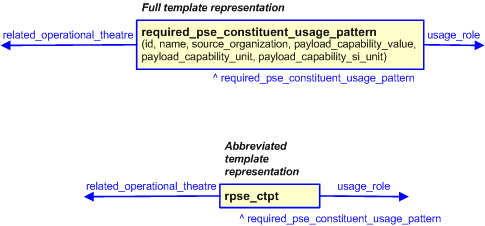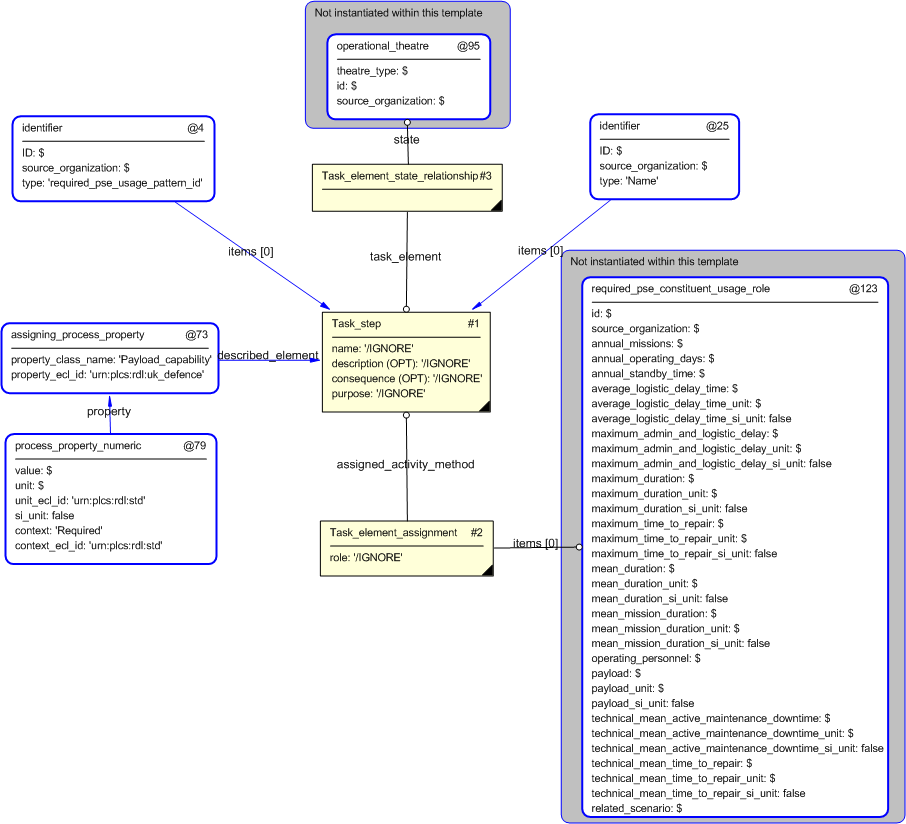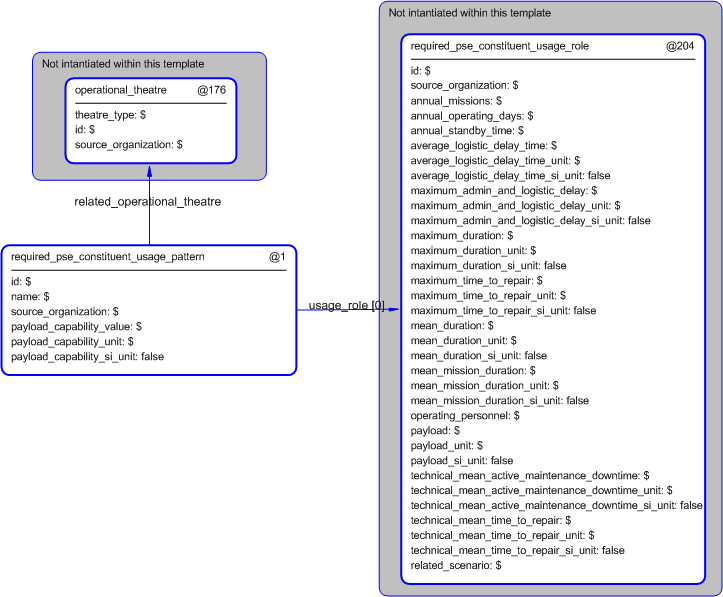Template:— required_pse_constituent_usage_pattern (rpse_ctpt)
Context:— UK_Defence |
Date: 2009/04/17 11:32:31
Revision: 1.7
|
This section specifies the template required_pse_constituent_usage_pattern.
NOTE
The template has been defined in the context of
UK_Defence.
Refer to the business context for details of related templates.
NOTE
An explanation of a template and the associated instantiation path is
provided in the
Template overview
section.
This template describes how to represent a required pattern of usage, in terms of usage phases, for the related PSE constituent.
Figure 1 — Graphical Representation for Business Object required_pse_constituent_usage_pattern
required_pse_constituent_usage_pattern
The definition of a required_pse_constituent_usage_pattern object is:
This information object represents information about an actual required_pse_constituent_usage_pattern of an individual
product.
|
Attribute name
|
Attribute description
|
Attribute type
|
Optionality
|
| ID |
This is the identifier of the required PSE constituent usage pattern. |
Identifier |
Mandatory |
| Identifier.id |
This is the value of the id attribute of the Identifier applied to the required PSE constituent usage pattern. |
intrinsic |
Mandatory |
| Identifier.type |
This attribute is the type associated with the id of the Identifier given to the required PSE constituent usage pattern. |
required_pse_usage_profile_id |
Mandatory |
| Identifier.source_organization |
This attribute is the value representing the source organization that provides the id of the Identifier given to the required
PSE constituent usage pattern. This value is assumed to be a type of Organization_identification_code.
|
Organization_identification_code |
Mandatory |
| Name |
This is the name of the required PSE constituent usage pattern.
EXAMPLE:
"Transatlantic flight",
"Low level bombing sortie".
NOTE: In each case, the overall usage from the point of pre flight checks, starting engines, leaving the parked
position, take off, flight, and right through to the point of landing, shutting down the equipment, and post flight checks,
is regarded as the usage profile.
|
intrinsic |
Mandatory |
| Payload capability |
This is the required payload capability for this usage pattern. |
Relationship to Measure With Unit |
Optional |
| Related operational theatre |
This is the reference to the operational theatre within which the usage pattern is required. |
Relationship to Operational theatre |
Optional |
| Usage Role |
This is a reference to the related Usage role |
Relationship to Required PSE Constituent Usage Role |
Mandatory |
Table 1 — required_pse_constituent_usage_pattern attribute details
The EXPRESS-G diagram in
Figure
2
shows the templates and EXPRESS entities that are required
to represent the template
"required_pse_constituent_usage_pattern".
The text highlighted in blue shows the template parameters.
Figure 2 — An EXPRESS-G representation of the Information model for required_pse_constituent_usage_pattern
The graphic for the template to be used in other EXPRESS-G diagrams
is shown in Figure
3
below.
Figure 3 — The graphical representation of the required_pse_constituent_usage_pattern template
The following input parameters are defined for this template:
This is the reference to the operational theatre within which the usage pattern is required.
This is a reference to the related Usage role.
This is the identifier of the required PSE constituent usage pattern.
This is the name of the required PSE constituent usage pattern.
An Organization representing the identification/rectification authority for the failure.
This is the required payload capability for this usage pattern.
The class name of the unit in which the probability is expressed.
The following classes and their sub-classes can be used:
Value should be set to true if the unit is a SI base unit defined by ISO, i.e.
kilogram (kg) for Mass,
second (s) for Time,
metre (m) for Displacement,
ampere (A) for Electrical current,
kelvin (K) for Temperature,
mole (mol) for Amount of substance, and
candela (cd) for Luminous intensity. If this is not the case it should be set to false.
Note that the representation of true and false depends on exchange format. In Part 11 (a STEP file) true is
represented by the string ".T.", and false by ".F.", while in Part 28 (XML) they are represented by text strings
"true"
and "false".
The following reference parameters are defined for this template:
Allow the
Task_step
entity instantiated in this path to be referenced when this template is used.
Note: The
Task_step
entity can be referenced in a template path by:
%^target = $required_pse_constituent_usage_pattern.required_pse_constituent_usage_pattern%
where
target
is the parameter to which the
Task_step
is bound.
The instantiation path shown below specifies the entities that are to be
instantiated by the template.
A description of templates and the syntax for the instantiation path is
provided in the
Templates Help/Information section.
-- create the task method to represent the required_pse_usage_profile Task_stepTask_step.name = '/IGNORE'
Task_step.description = '/IGNORE'
Task_step.purpose = '/IGNORE'
Task_step.consequence = '/IGNORE'
-- assign to required_pse_usage_profile %^required_pse_constituent_usage_pattern =
Task_step%
-- create the assignment to link the pse Task_element_assignmentTask_element_assignment.role = '/IGNORE'
Task_element_assignment.assigned_activity_method ->
^required_pse_constituent_usage_pattern
Task_element_assignment.items ->
@usage_role-- identifier /
identifier(
ID=@id,
source_organization=@source_organization,
type='required_pse_usage_pattern_id',
items=^required_pse_constituent_usage_pattern)/
-- identifier /
identifier(
ID=@name,
source_organization=@source_organization,
type='name',
items=^required_pse_constituent_usage_pattern)/
-- Payload capability /
assigning_process_property(
property_class_name='Payload_capability',
property_ecl_id='urn:plcs:rdl:uk_defence',
described_element=^required_pse_constituent_usage_pattern)/
-- Assign reference parameter -- not sure if needed - can we not substitute this string inside the call to process property? %^payload_capability = $assigning_process_property.property%
-- Value and Unit /
process_property_numeric(
value=@payload_capability_value,
unit=@payload_capability_unit,
unit_ecl_id='urn:plcs:rdl:std',
si_unit=@payload_capability_si_unit,
context='Required',
context_ecl_id='urn:plcs:rdl:std',
property=^payload_capability)/
-- create the assignment to link the pse Task_element_state_relationshipTask_element_state_relationship.task_element ->
^required_pse_constituent_usage_pattern
Task_element_state_relationship.state ->
@related_operational_theatre
The following entities are instantiated with attributes as specified:
The instance diagram in Figure
4
shows an example of the EXPRESS entities and templates that are instantiated by the template:
/required_pse_constituent_usage_pattern(id='', name='', source_organization='', payload_capability_value='', payload_capability_unit='', payload_capability_si_unit='.F.', related_operational_theatre='@176', usage_role='@204')/
(an illustration of the consolidated required_pse_constituent_usage_pattern template is shown in
Figure
5 below.)
Figure 4 — Entities instantiated by required_pse_constituent_usage_pattern template
The instance diagram in
Figure
5
shows the graphic symbol for the template that is to be
used in other instance diagrams. The example template is:
/required_pse_constituent_usage_pattern(id='', name='', source_organization='', payload_capability_value='', payload_capability_unit='', payload_capability_si_unit='.F.', related_operational_theatre='@176', usage_role='@204')/
Figure 5 — Instantiation of required_pse_constituent_usage_pattern template
Characterizations
No common characterizations of the template
required_pse_constituent_usage_pattern
have been identified. However, the ISO 10303-239 EXPRESS model
may enable other assignments to the entities instantiated by the template.
